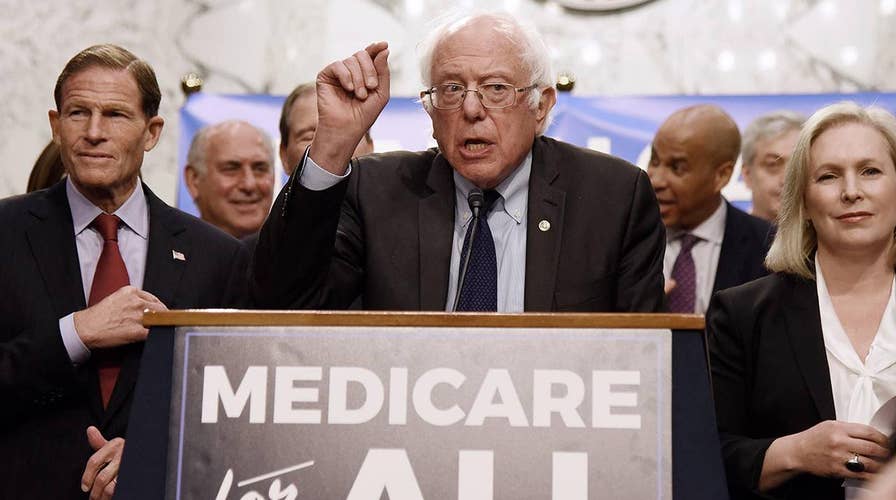Can America afford the $32.6T price tag for 'free' Medicare?
'Medicare for All' plan pushed by Sen. Bernie Sanders would increase government health care spending by $32.6 trillion over 10 years, according to a new study.
The “Medicare for All” plan pushed by Sen. Bernie Sanders and endorsed by a host of Democratic congressional and presidential hopefuls would increase government health care spending by $32.6 trillion over 10 years, according to a new study.
The Vermont senator has avoided conducting his own cost analysis, and those supporting the plan have at times struggled to explain how they could pay for it.
The study, released Monday by the Mercatus Center at George Mason University, showed the plan would require historic tax increases.
The hikes would allow the government to replace what employers and consumers currently pay for health care -- delivering significant savings on administration and drug costs, but increased demand for care that would drive up spending, according to the report.
According to the report, the legislation’s federal health care commitments would reach approximately 10.7 of GDP by 2022, and rise to nearly 12.7 percent of GDP by 2031.
But the study, conducted by senior research strategist Charles Blahous, said that those estimates were on the “conservative” side.
Sanders’ plan builds on Medicare, the insurance program for seniors. The proposal would require all U.S. residents be covered with no copays and deductibles for medical services. The insurance industry would be regulated to play a minor role in the system.
Sanders is far from the only liberal lawmaker pushing the program.
2020 hopefuls like Sen. Kamala Harris, D-Calif., and Sen. Elizabeth Warren, D-Mass., endorsed a “Medicare for all” program last year.
Political newcomer Alexandria Ocasio-Cortez, who beat House Democratic Caucus Chairman Joe Crowley, D-N.Y., in a recent upset primary and instantly became a prominent face of the democratic socialist movement, also is promoting a "Medicare for all" platform.
“Enacting something like ‘Medicare for all’ would be a transformative change in the size of the federal government,” Blahous, who was a senior economic adviser to former President George W. Bush and a public trustee of Social Security and Medicare during the Obama administration, said.
Blahous’ study also found that “a doubling of all currently projected federal individual and corporate income tax collections would be insufficient to finance the added federal costs of the plan.”
But Sanders blasted the analysis as “grossly misleading and biased,” noting that the Mercatus Center receives funding from the conservative Koch brothers. Koch Industries CEO Charles Koch is on the center’s board.
“If every major country on earth can guarantee health care to all, and achieve better health outcomes, while spending substantially less per capita than we do, it is absurd for anyone to suggest that the United States cannot do the same,” Sanders said in a statement. “This grossly misleading and biased report is the Koch brothers’ response to the growing support in our country for a ‘Medicare for all’ program.”
A spokesman for Sanders said that the senator’s office has not done a cost analysis on the new plan, however the estimates in the latest report are within the range for other cost projections for Sanders’ 2016 plan.
Sanders' staff found an error in an original version of the Mercatus report, which counted a long-term care program that was in the 2016 proposal but not the current one. Blahous corrected it, reducing his estimate by about $3 trillion over 10 years. Blahous says the report is his own work, not the Koch brothers'.
Also called "single-payer" over the years, "Medicare for all" reflects a long-time wish among liberals for a government-run system that covers all Americans.
The idea won broad rank-and-file support after Sanders ran on it in the 2016 Democratic presidential primaries. Looking ahead to the 2020 election, Democrats are debating whether single-payer should be a "litmus test" for national candidates.
The Mercatus analysis estimated the 10-year cost of "Medicare for all" from 2022 to 2031, after an initial phase-in. Its findings are similar to those of several independent studies of Sanders' 2016 plan. Those studies found increases in federal spending over 10 years that ranged from $24.7 trillion to $34.7 trillion.
The Mercatus study takes issue with a key cost-saving feature of the plan -- that hospitals and doctors will accept payment based on lower Medicare rates for all their patients.
The study found that the plan would reap substantial savings from lower prescription costs -- $846 billion over 10 years -- since the government would deal directly with drugmakers. Savings from streamlined administration would be even greater, nearly $1.6 trillion.
But other provisions of the plan are also expected to drive up spending, with coverage for nearly 30 million uninsured Americans, no copays and no deductibles and improved benefits on dental, vision and hearing.
The study estimated that doubling all federal individual and corporate income taxes would not fully cover the additional costs.
The Associated Press contributed to this report.





